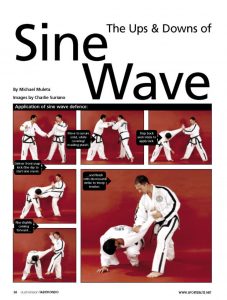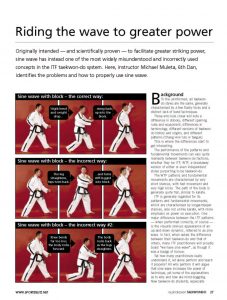Ups and Downs of Sine Wave
To the uninformed or uninitiated all Taekwon-Do’s are the same, just as all Karate’s are the same. Taekwon-Do is often characterised by a few flashy kicks and a often distinct lack of hand techniques, particularly to those who’s only exposure is via watching the Olympic sporting style.
Of course, those who cover the full composition of Taekwon-Do, in particular the Self Defense, understand there are many techniques not seen in competition sparring.
Casual observers who look a little closer will notice a difference in Doboks, starkly different sparring rules and equipment. Dig even deeper and there is difference in terminology, significantly different versions of Taekwon-Do history and origins, different patterns (Chang Hon tuls or taeguk) and a different dynamic of movement.
This is where the differences and variations start to get interesting.
The performance of the patterns, and fundamental movements can vary quite markedly between Taekwon-Do styles, whether they be ITF, WT, or an offshoot version of either.
The WT patterns and fundamental movements are characterised by generally short stances, with fast movement and impressively high kicks. The path of the body is generally quite flat, along the lines of traditional karate, but more upright in higher stances.
The ITF style is highly regarded for it’s patterns and fundamental movements, which are characterized by longer/deeper stances, also not unlike karate in some aspects, but with more emphasis on power of execution and a noticeably different dynamic of stepping.
The argument over which are better is in the eye of the beholder and the practitioner themselves.
One major difference between the ITF patterns, when performed correctly, of course, is the obvious appearance of a “up and down” path of travel, commonly referred to as Sine Wave.
In fact, so ingrained in this concept, that when asked the difference between their Taekwon-Do and that of others, many ITF practitioners will proudly boast “we have sine wave”, as if it were the key defining point.
Yet how many practitioners really understand it, let alone perform and teach it properly ? All who perform it will argue that Sine Wave increases power of technique, because that is what they have always been told.
But how, why and how much ? There’s where you get an array of responses.
With the onset of technology and the free sharing of information, many instructors now have a more informed knowedge of how sine wave works. However, still to this day, some of the explanations from others of why and how Sine Wave actually increased power are mind-boggling.
Sometimes you need to empathize with the new student coming into Taekwon-Do, and especially for those coming into ITF from another form of Taekwon-Do, where Sinewave was not emphasized, can find it confusing and stressful, even off-putting.
In my travels and training over 30 years I have seen Sine Wave performed in so many variations, even within the ITF, and heard so many differing explanations as to why and how it is to be performed. I’ve even observed instructors trying to get the sine wave concept across to beginners in their first class !!
Some senior instructors have been known to call it Sand Wave, or Sound Wave, due to difficulties deciphering Taekwon-Do Founder General Choi Hong Hi’s Korean accent during his seminars, along with their own non-mathematical background.
Ironically, those of us who have been around a while, all started Taekwon-Do when there was no SineWave. All the Pioneer Masters originally learnt without Sine Wave, many still struggle with the concept today. Taekwon-Do forged it’s reputation as the most powerful martial art, with great feats of destruction, long before the introduction of Sine Wave.
In this article, I will attempt to unlock some of the apparent myths, mysteries and confusion of sine wave.
The 2 most important things to emphasize here are that a) Sine Wave alone does not create power, and b) The body’s ‘Sine Wave’ trajectory is not exclusive to ITF Taekwon-Do
Sine Wave plays a bit part only, in contributing to generation of a powerful movement, in combination with all the other necessary components of force summation, breath control, timing, utilization of mass, acceleration of movement and so on.
You can have all the sinewave in the world, but if your movement lacks the transference of mass in the direction of the technique, and the rapid application of force, you will not have power…..period.
It is a dangerous and ignorant fallacy shared by many ITF practitioners, to think that any movement without obvious sine wave cannot be powerful.
There are many powerful techniques, performed by many martial artists, and in fact many athletes, that can produce incredible power, without ever having heard of sine wave.
Sine Wave – the name. Where the confusion begins.
The term sine wave is probably to first cause of the confusion and understanding.
Sine Wave refers to a mathematical graph often used when describing acoustics or simple harmonics.
A Sine Wave (or sinusoidal wave) is one that moves in a simple harmonic motion, where the oscillation is regular.
The diagram below demonstrates the cycle of a Sine Wave.
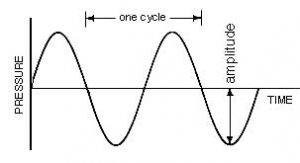
Confused yet ?
Ok, so now you can relate to the majority of ITF practitioners and prospective practitioners who don’t have the mathematics or physics background to cope with such a concept.
So many settle with the ‘down-up-down’ explanation.
So what is Sine Wave ?
Let me emphasize that Sine Wave should be a natural movement, not a forced or conscious action. Being a natural movement, it often occurs without having to ‘create’ it.
The focus should be on the technique you are about to execute and focussing all your power into the blocking or attacking tool.
During a ‘normal’ or regular stepping motion, Sine wave is generally created by the relaxation, or un-weighting, of the leg muscles at the initial stage of the technique’s execution, whether it be whilst stepping or whilst stationary.
It is this relaxation of these muscles which causes the body to drop slightly. This drop is subtle, rather than a distinctive ‘squat’. The body should be relaxed during this phase.
This is, in part, synchronized with the backward motion referred to in the ‘Training secrets’ … “every movement begins with a backward motion”, with the arms reaching their intermediate preparation position for the technique about to be executed.
The practitioner then increases their height, by extending their legs, but not fully locking them out, before dropping their body weight again as they lengthen their stance to execute the technique.
It is this dropping which incorporates our body’s mass into the technique, utilizing the kinetic energy and gravity, to assist in adding to the power of the movement.
It is important that, whilst stationary, the heel remains flat on the ground and whilst traveling the foot remains flat and only slightly above the surface of the ground (a few millimeters, rather than centimeters).
Sine Wave and different types of motion
In addition to Sine Wave whilst stepping in a regular fashion, we also have numerous speeds/types of motions which effect the type of sine wave executed.
Sine Wave in Slow motion
During Slow Motion movements, Sinewave is very much manufactured and artifical.
The trajectory is performed as usual, commencing with a slight downward motion, then upwards, and then downwards again. However, the movement is performed slowly in conjunction with slow breathing. An example where this is evident is the Palm Pressing Blocks in Joong-Gun tul.
Sine wave is slow movements is a little redundant, as during a slow movement there is not a natural relaxation or unweighting of the joints, and also given the purpose of Sine wave is to contribute to power generation, slow movements are not powerful.
Thus in slow movements, we are merely mimicking the posture, technique and trajectory to show balance, control and for aesthetics. There are no real-life applicable Taekwon-Do techniques that are performed slowly.
Sine Wave in Fast motion
The Sine wave is still performed as per usual. The major difference between Fast and ‘normal’ movements, is the time interval the foot spends flat on the ground between movements is much shorter. You should still execute one sharp breath for each technique. An example of this concept is the two punches, as can be found in Do-San tul and Yul Gok tul.
Many practitioners merely perform what is nown as a ‘saw-tooth’ (up-down) motion in these instances. We explain the saw-tooth concept a little later.
Sine Wave in Continuous motion
In this case there is no pause between the end of one movement and the execution of the next. An example is the Outer Forearm Low Block and the Rising Block in Dan-Gun tul. You should still have one breath and create a separate Sine Wave for each technique.
In reality however, many of the examples of connection motion involve an initial movement which performers don’t execute with full power, and load up on the secondary movement, despite no specific documented instruction to perfrom this way.
In this case, the secondary moevent does not really take advantage of sine wave, as the step is generally completed with the first movement. It is more of a ‘knee-spring’ scenario with the secondary movement.
Sine wave is NOT performed where the performer does not actually step.
Many instructors refer to sine wave when they mean knee spring. Sitting stance punch is a classic example.
Sine Wave in Connecting motion
In Connection motion, there is also no pause between two techniques, however in this case, there is only one breath and one Sine Wave for the two techniques, which is performed at the end of the second movement. An example of this Connecting Motion is the Palm Upward Block and Middle Punch in Ge-Baek tul.
Again, in most these cases, the intial movement is generally not a full power tehnique, so sine wave is not really utilized for the purpose it is intended. Once again, as the step is completed with the initial movement, it is more a ‘knee-spring’ where the secondary movement is only accompanied by the drop in body weight.
Practical Application of Sine Wave
It is often an interesting exercise to watch a practitioner who swears by the Sine Wave as the be-all and end-all of ITF technique.
They will perform their patterns with a great emphasis on Sine Wave, and Step Sparring likewise.
However, when performing Self-Defence and often breaking techniques, the SineWave often goes out the window.
There is no reason why SineWave can’t be executed during Self-Defence movements, however again, the over-exaggeration and the time taken to complete a technique often renders that impractical.
Again, because often the full attention is on ‘creating’ the SineWave, rather than the actual purpose of the technique. Sine wave that is too deep and too slow, makes the technique ineffective against an attacking opponent.
In competition type sparring, Sinewave is virtually non-existent, as the objective in ITF sparring is not maximum power, rather maximum speed.
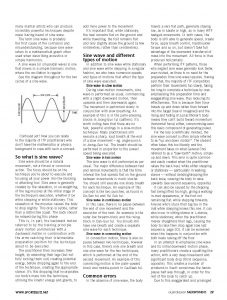
Common errors
The Up/Down version
For the less scientifically minded, the Sine Wave concept is often simply referred to as ‘up and down’ motion.
The student often takes it too literally and the movement takes on a Mr Squiggle look about it. General Choi referred to this type of motion as a ‘saw-tooth’ motion, simply up and down.
This error is quite common and easily created when the practitioner raises the back heel, while either stepping or stationary (particularly in walking stance) without bending/dropping the back knee, causing the body to raise ‘upwards’.
It can also be caused by the stepping foot to be lifted too high, giving a ‘walking in mud’ appearance, or the foot not remaining flat, whilst stepping forwards. Anyone who had stuck their big toe in the mat whilst stepping knows this one.
It can also occur in Sitting Stance or L-Stance, whilst stationary, when the practitioner merely straightens their legs, causing the body to raise and then drops again. It can be further made the look worse when this happens in conjunction with both heels raising off the floor.
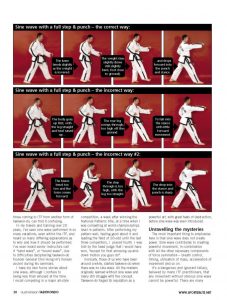
The Sine Wave Squat
In an attempt to emphasize Sine Wave, and it’s initial downward motion/phase, many practitioners create a squatting-like action, with a very deep knee bend and significant body drop. Sometimes the back knee almost touches the floor.
This creates a number of problems in itself:
- due to the time taken to travel the extra vertical height caused by the deep squat, the tools used for blocking or striking have to take an exaggerated preparation, slowing the execution time down quite markedly.
- Sometimes the hands even pause half way through in order for the rest of the body to catch up.
- The movement due to this exaggerated and prolonged preparation process, takes on an unrealistic look about it, and reduces it’s practicality in actual self-defence.
I’ve lost count of the many times I’ve seen students perform very prominent Sine Wave, yet execute very little power due to the absence of many of the other necessary components of Power, and still take out awards in Patterns competition, because often judges look for the visually obvious oscillations, rather than the purpose, realism and ‘actual’ power of the movement.
This misnomer has even crept into International competition, where competitors adopt strategies such as exaggerated stepping, or sharper head rotations and loud breaths or kihaps to disguise lack of power.
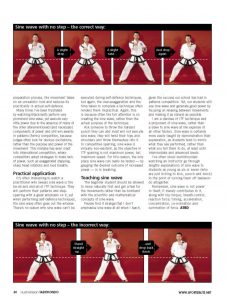
Absence of Sine Wave
In the absence of Sine Wave, the body travels a very flat path, generally staying low, as in Karate, or very high, as per many WTF taekguk movements.
These are not incorrect, they are merely particicular to that style.
In both cases the body is still able to generate speed, create force, apply breath control, hip and shoulder torque and so forth, but does not take full advantage of the downward transferring of mass into the movement.
When performing ITF patterns, they have a tendency to look faster, even rushed at times, as there is no need for the preparation time Sine Wave requires. This is a charateristic of how the ITF Tul were performed in the early days. Many Taekwon-Do people say. ‘oh it was Taekwon-Do patterns performed in karate fashion’. This is also incorrect, becuase this was the Taekwon-Do of the time, as taught by the Founder, General Choi Hong Hi.
With the introduction of sine wave almost 40 years ago, or more to the point the overemphasis of it, the dynamic and rhytym of movement has changed signifcantly.
Having said that, my observation is that the majority of ITF competitors perform their movements too slowly, taking too long to complete a technique by over emphasizing this preparation time and exaggerating Sine Wave, reducing it’s effectiveness.
Summary
It cannot be stressed enough to allow the beginning student to move naturally first and get a feel for the movements rather than bombard them with Scientific and Mathematical concepts of SineWave.
People are often bewildered when I tell them that I don’t emphasize SineWave at all when I teach, given the success our school has had in ITF patterns at all levels. Yet, our students still execute Sine Wave and generate good power by focussing on relaxing between movements and making it as natural as possible.
Yet, I am a devotee of ITF technique and an opponent of Sine Wave, rather than a slave to Sine Wave at the expense of all other factors.
Sine Wave is certainly easier taught by demonstration rather than explanation, as students tend to mimic what they see performed, rather than what you tell them to do, at least until intermediate and advanced levels.
I’ve often stood there dumbfounded to observe an instructor try and rationalize and explain for ages SineWave to students as young as 6 or 7 years of age, to the point of overkill, turning the student who is just itching to kick, punch and block, off Taekwon-Do altogether
Remember, SineWave is not Power in itself, it merely contributes along with hip torque, breath control, reaction force, timing, acceleration, concentration, co-ordination and force summation.
 written by Master Michael Muleta, 8th Degree
written by Master Michael Muleta, 8th Degree
- President – United ITF Taekwon-Do Australia
- CEO – Global Fitness Institute


